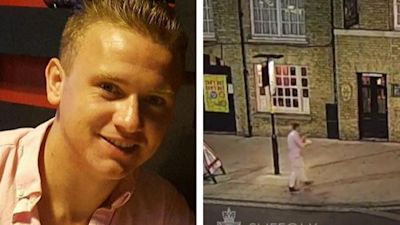Corrie McKeague: Police tell inquest they don't believe man bin lorry driver saw was missing airman

Police have told an inquest they do not believe that a man described by a bin lorry driver, close to where Corrie McKeague was last seen on CCTV, was the missing airman.
Mr McKeague disappeared in the early hours of September 24, 2016, after a night out in Bury St Edmunds, Suffolk.
The RAF gunner was last seen on CCTV at 3.25am entering a service area behind a Greggs store and police believe he climbed into a bin which was then tipped into a waste lorry.
The serviceman was wearing white trousers and a pink shirt in CCTV images.
Bin lorry driver, Martyn Thompson, who tipped a bin in the area at 4.19am, earlier told the inquest in Ipswich that he had checked inside the bin before tipping it, and that nobody was inside it.
He also said he had seen a man in light-coloured trousers and a pink shirt standing in the area and using a mobile phone.
Lawyer Dr Anton van Dellen, asking questions on behalf of Mr McKeague's father, Martin McKeague, asked Chief Superintendent Marina Ericson "if it was the police view" that the man seen by Mr Thompson in the service area "was Corrie".
"No," said Ch Supt Ericson, who became senior investigating officer from November 2017.
Dr Van Dellen said that a man, wearing a yellow top, blue hoody and dark trousers, was seen on CCTV using his phone by the service area before walking in, and he suggested this could have been the man whom Mr Thompson saw.
The inquest heard that the man in the blue hoodie was traced by police and spoken to.
Dr Van Dellen said Mr Thompson was informed on September 29 by an operative at the Biffa depot in Bury St Edmunds that police wanted to speak to him.
He said Mr Thompson gave his initial account to the police later that day.
He said that Mr Thompson, in his initial account, described seeing a "smartly-dressed, white male in light coloured clothing with light-coloured trousers, holding a mobile phone, he appeared to be 18 to 20 years old".
He later gave his first witness statement, on October 5 2016.
In it, Mr Thompson described the man as "18 to 22 years old, smartly-dressed" with a "pink, light-coloured shirt which he believed to be long-sleeved", adding that he had "light brown or blonde-coloured hair that was short at the sides but longer at the top", Dr Van Dellen said.
Ch Supt Ericson agreed with the lawyer that this was "more detail, more specific than his first account".
She agreed with him that a possible explanation was that, between his initial statement on September 29 and his first witness statement on October 5, Mr Thompson "has been exposed to newspaper coverage or a media appeal for Corrie with that description and his evidence has become coloured, even if subconsciously".
Ch Supt Ericson agreed with Dr Van Dellen that a second possible explanation was that Mr Thompson "has effectively deliberately described (the man) with that description to place, potentially, Corrie away from the bin and superimpose Corrie's description on (the man)".
In a second witness statement on November 21, 2016, Mr Thompson added that the man's shirt was "slim-fitting with a collar", Dr Van Dellen said.
He asked Ch Supt Ericson why police do not believe that Mr Thompson checked inside the bin.
She replied: "It's a culmination of all the evidence that's held in this case.
"We now know that that bin weighed 116kg.
"We now know that was an extremely heavy weight for that particular bin on a Saturday.
"We've found no other explanation for what could have been in that bin that would have constituted that weight.
"We have the additional evidence of Corrie's phone tracking the bin lorry on its journey."
The inquest, being heard with a jury, continues.